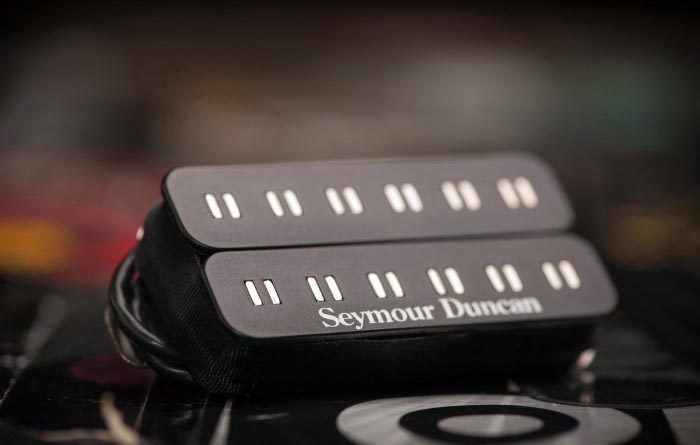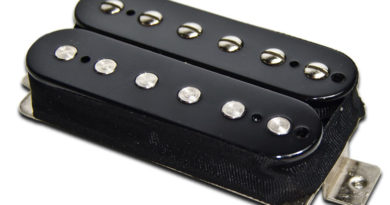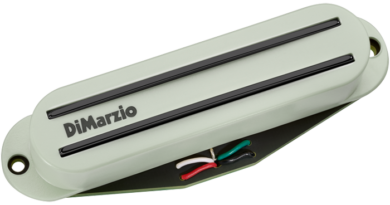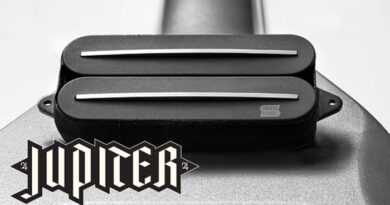Seymour Duncan Parallel Axis Blues Saraceno PATB-3
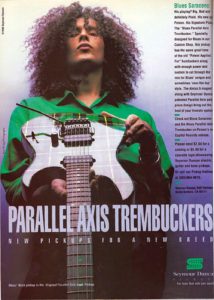
The Blues Saraceno PATB-3 bridge humbucker is another one of those that seems to fly under the radar. Then again, the entire Parallel Axis series seems to do the same. When this line of pickups hit the shelves in 1993, it’s the pinnacle of shred guitar. The fleet-fingered are looking for every edge to maximize their footprint on the sonic landscape. As so many guitars of the day work away from what’s considered “standard” string spacing, there has to be more than just moving the poles out a couple of millimeters.
Outside of the blade/rail design most commonly associated with Bill Lawrence, the dual-pole (or dual-staple) design of the Parallel Axis series might be one of the more innovative approaches to wrapping the magnetic field around the strings.
“Oh, but I play a non-trem guitar, so that’s not for me” you say. Oh really? Get out a ruler and check your string spacing. Some people might be surprised. Even still, the PATB neck model is standard-spaced and one of the handful of neck pickups that I give a thumbs-up.
The PATB-3 plays right in that vintage and vintage-hot territory that the Duncan company seems live in. While not as hot as the PATB-1 Original or rigidly compressed as the PATB-2 Distortion, there’s a more open and lively character going on that lends itself to a greater versatility that can go from polite to rude.
For some reason, the Parallel Axis series doesn’t seem to grow on trees if you tend to hunt the online resources like I do. Once I laid hands on a PATB-3, I installed it in a 2-hum trem-equipped (of course!) guitar with a PATB-1n in the neck. Each pickup has it’s own switching for series/split/parallel operation.
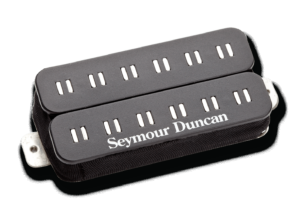
Once up and going, the PATB-3 has about the same moderate output level of something like the Whole Lotta Humbucker, the Screamin Demon, the Alnico II Pro, or the 78 Model. Let’s face it, you can cover a lot of ground with a pickup in that range when considering the type of amps we have to work with these days.
While I previously considered the PATB-1 Original as my undisputed favorite Parallel Axis, the PATB-3 steps up to the plate to deliver some tone. With a slightly lower resonant peak and a bit more of a scooped P.A.F. character than the PATB-1, the PATB-3 is voiced for an open and musical vibe.
There’s really not much need to mess with different dirty tone options on an amp. The PATB-3 responds well enough to picking styles and fretting subtleties that the bases are covered. It’s also a great selection for a bit of the old brown sound, if I say so myself. When dialed in just right, the nature of the dual-pole’s magnetic field almost propels the string to sustain longer.
Clean amp tones work pretty well with the PATB-3. You can dial down the volume pot a touch if you want, or take advantage of some of the wiring options afforded by the 4-con lead wire. Going to the middle position and selecting some split and parallel options of both pickups revealed some excellent clean tones full of chime and spank.
Put your peepers on this video of the PATB-3 in action:
Want some specs?
Inductance – 5.652 H
North – 4.446 K
South – 4.564 K
Parallel – 2.251 k
Mids – 3
Treble – 6
Resonant Peak – 6 KHz (advertised)
Magnet – Alnico 5
Look at those metered specs and you might get where I’m talking about that brown sound. I’m wondering if this pickup is an Alnico 2 away from runnin’ with the devil. I mean, if you’re into voiding a warranty to swap a magnet. LOL! But seriously, the PATB-3 is going to be good for rock, punk, pop, country, probably some metal, maybe some jazz.
Seems like the Parallel Axis series are criminally over-looked and under-advertised. Put down the pedals and step away from the Bonamassa. Some of the existing selections in the established catalog are still fresher than showering outdoors! HaHa!
For reference, this Parallel Axis Blues Saraceno PATB-3 pickup evaluation was conducted with a Fractal Axe-Fx II XL+ featuring Celestion Impluse Responses and Fractal MFC-101 MIDI Foot Controller. Real cabs used were Marshall 1960B cabs loaded with Celestion G12-65s, Vintage 30s and G12M Greenbacks.
Seymour Duncan Website | Facebook | Twitter | YouTube | Instagram

